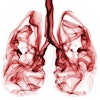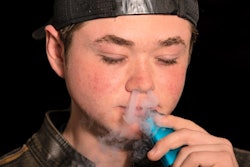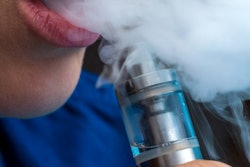
The rapidly growing popularity of vaping -- and the concomitant rise in vaping-associated lung disease -- has made it more important than ever for radiologists to recognize the clinical signs of lung disease associated with the phenomenon, according to researchers from the Mayo Clinic.
"The incidence of e-cigarette use has exponentially escalated in school-age children," noted senior author Dr. Patricia Mergo, a thoracic radiologist at the Mayo Clinic in Jacksonville, FL, and colleagues, in an e-poster at ECR. "The incidence of e-cigarette or vaping product associated lung injury (EVALI) soared in late 2019, with vitamin E acetate identified as a causative agent, used as a solvent primarily in tetrahydrocannabinol (THC)-containing vaping products."
Radiologists must get savvy about commercially available vaping devices, understand the basic mechanism of action of vaping devices, and recognize the radiographic findings of vaping-associated lung injury (VAPI) and EVALI, they urged in their e-poster exhibit, which received a certificate of merit.
Mixing of cannabis
As of 7 January 2020, vaping lung disease accounted for 57 deaths in the U.S., and over 2,600 cases of lung injury were attributable to e-cigarette use. Many of the cases involved the mixing of cannabis components with the e-cigarette vaping liquids.
Devices now available can be compact in size, explained Mergo and her colleagues. Juul pods are very popular devices, but they have lost favor recently in part due to negative publicity related to EVALI. A single Juul pod delivers the nicotine equivalent of 30 cigarettes.
"One of the more popular devices now amongst adolescents and young adults is the Puff Bar device. It comes in a wide array of flavors that are highly appealing to young adults and children. Banana Ice is a particularly popular flavor and tastes like banana NERD candy," they explained. "Empty refill cartridges can also be readily purchased online and can be filled with anything, including THC products."
The histopathology of EVALI is characterized by severe bronchiolitis (with mucosal edema, sloughing of epithelium, and peribronchiolar organization). Foamy lipid-laden macrophages may also be seen, and severe injury can progress to diffuse alveolar damage or formation of hyaline membrane.
The clinical course from onset of symptoms is short and begins with an exudative edematous phase, progressing to an acute inflammatory phase within one to five days and evolving into an organizing fibrinous phase within one to two weeks, the authors wrote.
"In early investigations, four radiographic patterns have been described. These include organizing pneumonia, diffuse alveolar damage, diffuse alveolar hemorrhage and centrilobular nodularity. Interestingly, many of the cases have additionally shown the finding of subpleural sparing of disease," they continued.
The number of new EVALI cases seemed to plateau in late 2019 due to the identification of vitamin E acetate as a causative factor, but new cases are still arising. Legislative actions are being taken to provide better regulation of the availability of the vaping products and to diminish their availability to children in the U.S., but vaping remains an epidemic in school-age children, especially adolescents and teenagers, and is extremely popular on college campuses across the U.S., Mergo and colleagues pointed out.
Experience of Mayo Clinic
The pulmonary imaging manifestations associated with e-cigarette use can mimic those of hypersensitivity pneumonitis, acute respiratory distress syndrome (ARDS), organizing pneumonia, and fibrosing-interstitial lung disease, most notably nonspecific interstitial pneumonia (NSIP).
Over 75 patients have presented to the Mayo Clinic with histories and/or radiographic patterns of disease that were suspicious for possible cases of EVALI, Mergo and colleagues explained. In a review of the medical records (with approval of the institutional review board), 10 patients were identified with the diagnosis of EVALI. All patients had radiographic patterns that fit into one of the described four patterns of disease: organizing pneumonia, diffuse alveolar damage, diffuse alveolar hemorrhage, and centrilobular nodularity. Most patients also demonstrated the finding of subpleural sparing of disease.
In the case of a 71-year-old woman, the initial radiographic pattern was thought to be due to possible EVALI, but the diagnosis was not included in the diagnostic report initially because of the age of the patient. This case highlights the fact that while EVALI is seen most commonly in young adults, often men, patients outside of the usual demographic parameters can also unexpectedly present with EVALI, the authors noted.
Another patient, a 26-year-old male, experienced respiratory arrest during his hospitalization with successful resuscitation following intubation. He was subsequently extubated and recovered fully.
"The characterization of this group of patients is preliminary and ongoing and the imaging findings and clinical course, along with pathologic correlation when available, will be reported in upcoming investigations," the authors concluded.
Editor's note: To view the authors' full e-poster, go to the European Society of Radiology's EPOS website. The lead author was C. Kiel from Gainesville, FL.



















